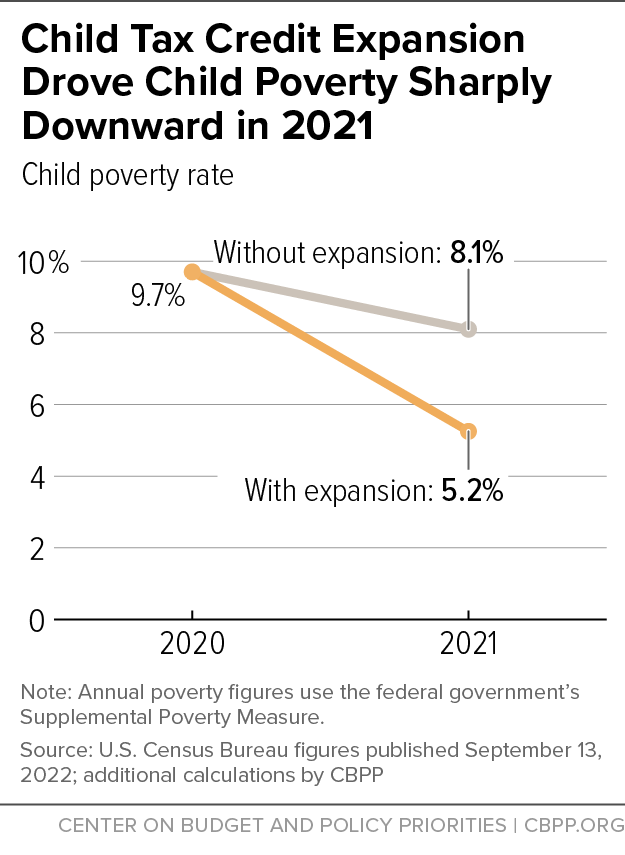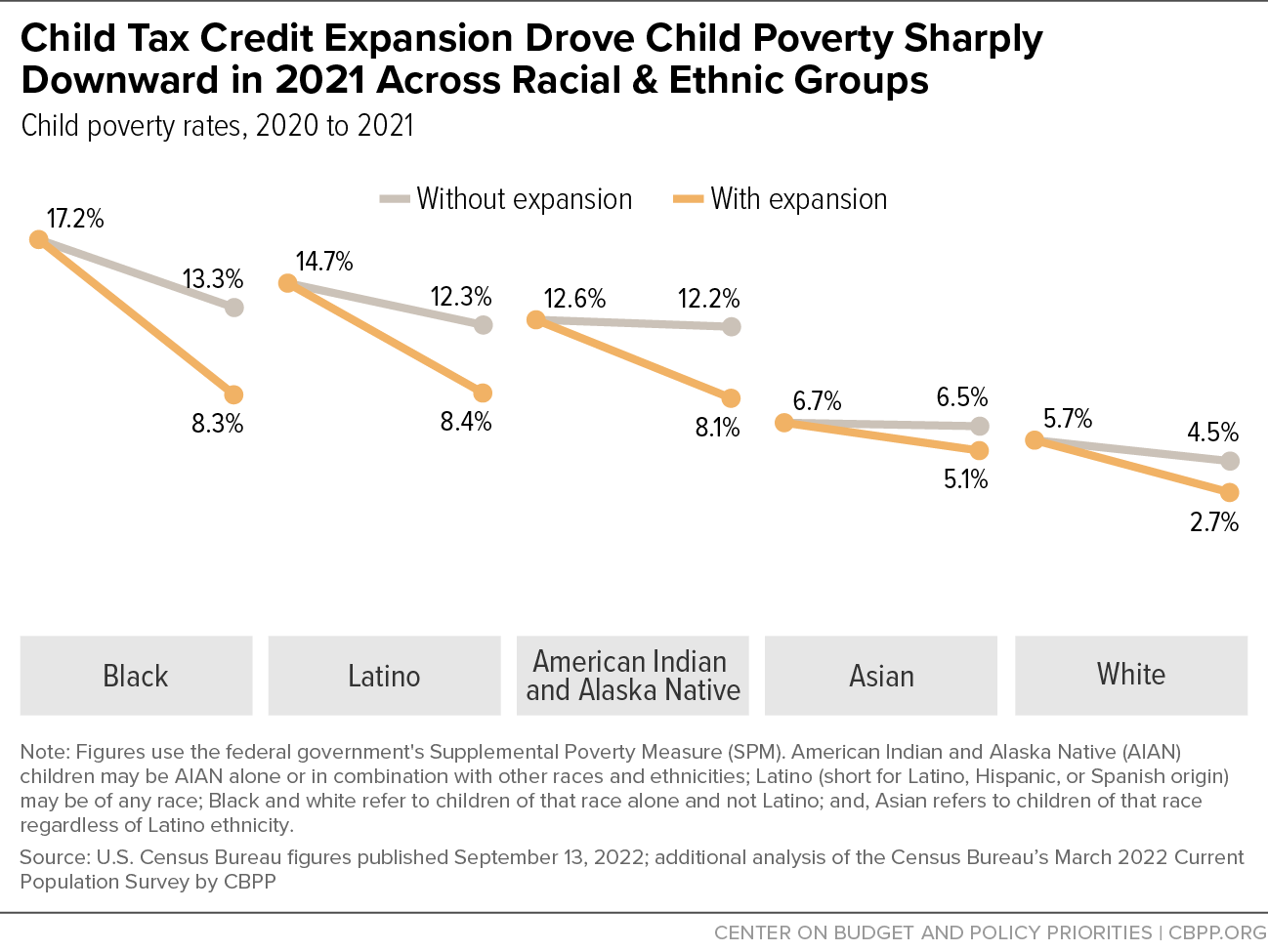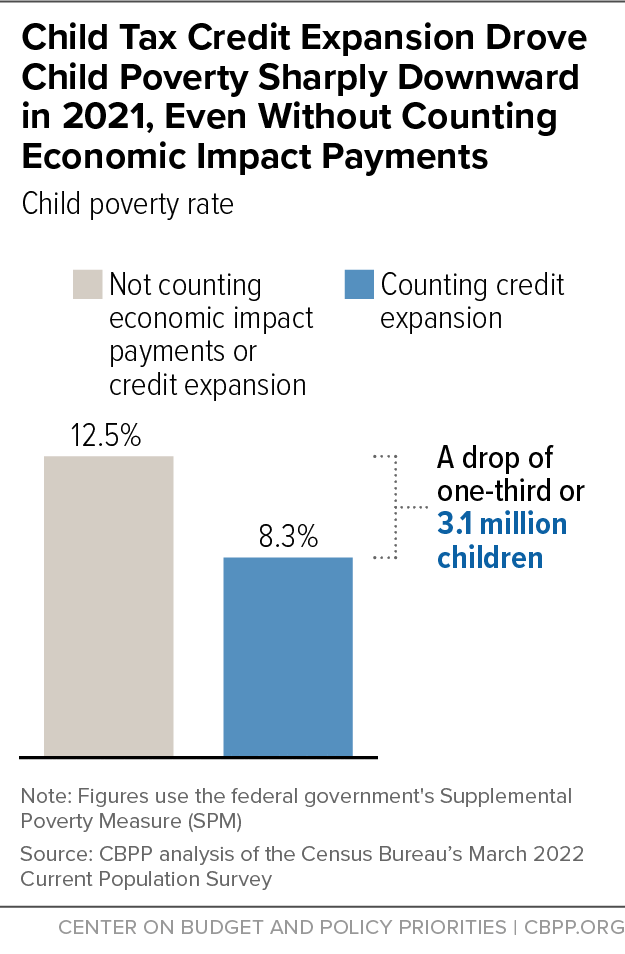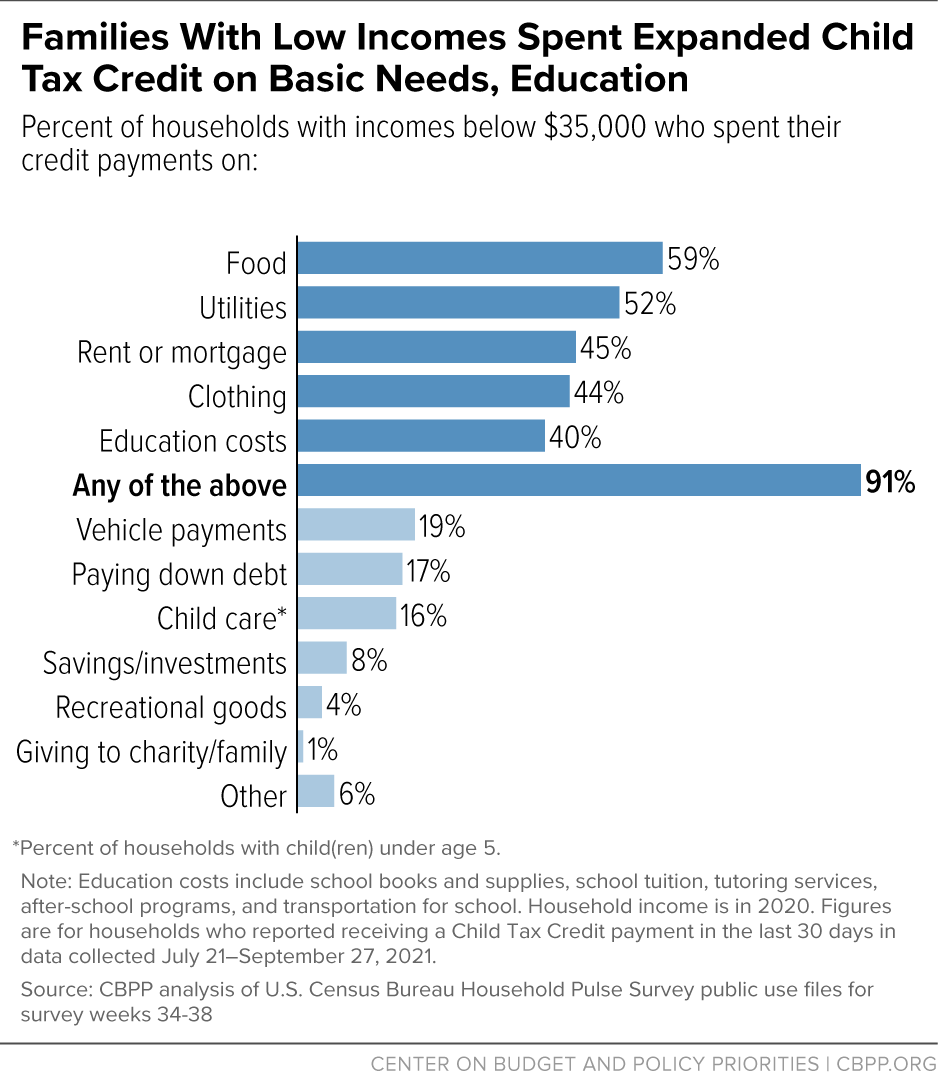The Child Tax Credit expansion drove child poverty sharply downward in 2021. Combined with other relief efforts, the expansion helped lower child poverty by more than 40 percent between 2020 and 2021, reaching a record low of 5.2 percent, Census Bureau data released last week show. The credit’s expansion expired at the end of last year, but policymakers can renew this successful poverty-fighting policy in year-end bipartisan tax legislation.
There is pressure on Congress from business interests to delay a corporate tax increase; Congress should not consider any business tax breaks without also expanding the Child Tax Credit.
The new Census data are the clearest evidence to date of the expanded Child Tax Credit’s success. Without the expansion (but with other relief measures in place), the child poverty rate would have dropped from 9.7 percent in 2020 to 8.1 percent in 2021, according to the Census Bureau data. But with the American Rescue Plan’s Child Tax Credit expansion, the rate fell to 5.2 percent, keeping some 2.1 million additional children out of poverty.[1]
An expansion of the Child Tax Credit, particularly for low-income families who today receive less than the full credit, is even more important going forward because other relief measures — such as economic impact payments — that also boosted families’ incomes during the COVID-19 pandemic have expired.
Congress and the Biden Administration now face a stark choice: whether to expand the Child Tax Credit or allow all of the gains against child poverty made over the last two years to evaporate, with millions of children needlessly falling back below the poverty line. Research has found that additional income from policies such as the Child Tax Credit improve the health, educational achievement, future earnings, and lifelong prospects of children in low-income families. The new Census data underscore that this policy success — if policymakers act — could change the future for millions of children in our country.
Year-end legislation will need to be bipartisan, and there is bipartisan support for expanding the Child Tax Credit.
Democratic champions have noted the strong poverty impacts of the expansion[2] and have renewed their commitment to expand the credit, which has also been a top priority of the Biden Administration. And some Republicans, who expanded the Child Tax Credit in 2017 in their tax cut bill as well as in the 2001 tax cut bill, have also shown signs of interest in expanding the credit. Senator Mitt Romney[3] recently proposed an expansion of the Child Tax Credit and Senator Marco Rubio, who with Senator Mike Lee was central to the inclusion of an expansion in the 2017 tax law, also released a Child Tax Credit expansion plan with Representative Ashley Hinson.[4]
There is a possible path for bipartisan year-end legislation. As they have in prior bills this year, corporate lobbyists are pressing Congress to delay a tax increase enacted in the Trump 2017 tax law related to the tax treatment of research and experimentation (R&E) expenses before the end of the year. In 2017, to reduce the cost of cutting the corporate tax rate to 21 percent, congressional Republicans required businesses, beginning in 2022, to deduct the costs of their R&E investments (or “amortize” them) over five years instead of deducting the full costs immediately. At the time, the Joint Committee on Taxation (JCT) estimated that this would raise $120 billion over ten years.
If Congress now wants to reverse this policy — and return the tax treatment of R&E investments to immediate expensing — then it should simultaneously reverse a corresponding amount of the deep cut in the corporate tax rate. But that is unlikely to happen in year-end bipartisan legislation. Meanwhile, corporate interests are expected to continue to press aggressively for a delay of the R&E provision, which would mean yet another corporate tax cut.
Policymakers should not put corporate interests ahead of the interests of children. That means that this corporate tax cut related to R&E expenses — or any other business tax cut — should not move without an expansion of the Child Tax Credit. Some policymakers have already made clear that they do not support moving ahead with a corporate tax break without an expansion in the Child Tax Credit. For example, in response to the Census report, Senators Bennet, Brown, and Booker and Representatives DeLauro, DelBene, and Torres said that Congress should not enact corporate tax provisions in year-end legislation without also expanding the Child Tax Credit.[5]
The child poverty rate fell to a record low in 2021, the Census Bureau announced on September 13. The rate fell by 4.5 percentage points, from 9.7 percent to 5.2 percent — the largest year-to-year drop ever. The rate is a record low not only in Census figures that start in 2009 but in analyses of historical data assembled by Columbia University back to 1967.
In 2021, two policies in particular drove down child poverty — the expanded Child Tax Credit and the third round of economic impact payments. In the last two recessions, the federal government used broad based stimulus payments to help households weather the economic downturn and to boost demand to help the economy recover.
If the Child Tax Credit had not been expanded (but with the economic impact payments and other policies in place), the child poverty rate would have stood at 8.1 percent. With the Child Tax Credit expansion also in place, the child poverty rate fell to 5.2 percent. (See Figure 1.)
Without the Child Tax Credit expansion, some 2.1 million more children would have been in poverty in 2021 — including 752,000 Latino children, 649,000 white children, 524,000 Black children, 89,000 American Indian and Alaska Native children, and 56,000 Asian children, based on Census estimates of families’ taxes.[6] Moreover, the Child Tax Credit expansion improved conditions for children of all races and ethnicities and narrowed differences in poverty rates between them. (See Figure 2.)
Since economic impact payments are not being considered as an ongoing policy, another way to look at the data is to consider what the child poverty rate would have been in 2021 if there were no economic impact payments and no expansion in the Child Tax Credit. Without both of these policies, child poverty would have stood at 12.5 percent. Adding in the expanded Child Tax Credit (without the economic impact payments) would have reduced the number of children in poverty by 3.1 million and reduced the child poverty rate to 8.3 percent, itself a historic low, a reduction of one-third. (See Figure 3.)
The Rescue Act made the full Child Tax Credit available to children in families with low earnings or that lack earnings in a year, and it increased the credit’s maximum amount to $3,000 per child and $3,600 for children under age 6. It also extended the credit to 17-year-olds. The increase in the maximum amount began to phase out for heads of households making $112,500 and married couples making $150,000.
For example, a single mother of a toddler and a second grader, who earns $14,000 a year providing in-home care to older people (with work hours that fluctuate significantly from month to month), received a Child Tax Credit of $1,725 in 2020. Under the Rescue Plan for 2021, this family received a $3,600 credit for the toddler and $3,000 for the second grader, for a total of $6,600 delivered in stabilizing $550 monthly amounts during the second half of 2021. That was a gain of $4,875 relative to 2020. Millions of such families benefitted from the Rescue Plan’s expansion.
The Census Bureau provided real-time data on how parents were spending these monthly deposits and what this meant for children. Food topped the list of how families with low incomes used this money. (See Figure 4.)
As a result, for example, in the month and a half after the federal government began issuing monthly payments of the expanded Child Tax Credit, the share of adults living with children reporting that their family didn’t have enough to eat in the past seven days fell significantly.[7] The prevalence of food insecurity among households with children fell substantially, from 14.8 percent in 2020 to 12.5 percent in 2021, and nearly 2.5 million fewer children lived in households that experienced food insecurity. The share of households where children were food insecure reached a two-decade low in 2019 (6.5 percent of households with children) but increased significantly early in the pandemic, rising to 7.6 percent of households with children in 2020. However, this measure returned to the pre-pandemic low in 2021 (6.2 percent).[8]
For children, poverty can mean unstable housing, frequent moves, inadequate nutrition, and high levels of family stress, and other problems. These in turn have been linked with lower reading and math scores, more emotional and behavioral problems, fewer years of completed education, lower earnings, higher likelihood of being arrested, and poorer health in adulthood, a 2019 National Academies of Science, Engineering, and Medicine report on reducing child poverty found. “[T]he weight of the causal evidence indicates that income poverty itself causes negative child outcomes, especially when it begins in early childhood and/or persists throughout a large share of a child’s life,” the report concluded.[9]
By contrast, boosting children’s inadequate family incomes with an expanded Child Tax Credit and reducing poverty over the long term would mean better lifetime health, improved educational attainment, and higher earnings and better economic circumstances as adults.
Contrary to predictions that the credit would trigger major declines in parental employment, the number of working-age adults working a large share of the year rose by similar amounts for those with and without children. The number of adults aged 18 to 64 who worked full time, year-round rose by 10 million in 2021 — the largest such increase since at least the 1980s — Census reported, and analysis of the survey data indicates that the rise in the share working full time, year-round was about as large among adults in families with children under 18 (up 5.8 percentage points) as without children (up 5.2 percentage points). Similarly, the share working the equivalent of at least half the year (1,000 hours) rose as much among those with children as those without children.[10]Although most parents received the Child Tax Credit payments starting in July, there was no obvious sign of a relative decline in either of these measures of parents’ employment.
Without action to expand the Child Tax Credit (and with the expiration of various relief measures), child poverty is likely to return to about the same level as it was pre-pandemic — pushing millions of children back into poverty. This presents Congress and the Biden Administration with a stark policy choice to make this year — they can take steps to expand the Child Tax Credit and make sustained progress in reducing poverty, or they can see all of the gains made in recent years evaporate.







